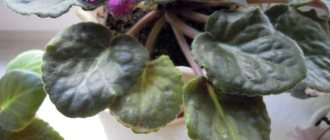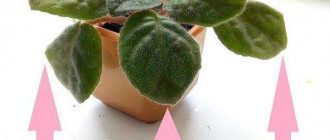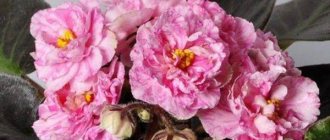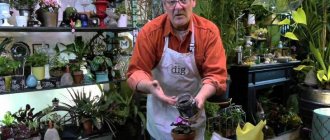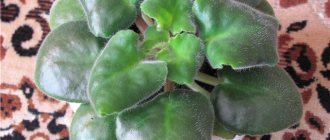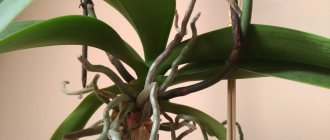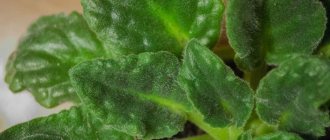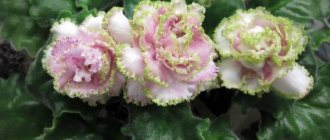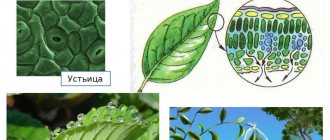The flowering of violets is greatly influenced by the conditions in which the plant is grown . This especially affects young specimens.
Low or high temperatures, chemicals or age of seeds can give rise to mutations that can allow you to grow a new beautiful variety or turn a flower into a “gray mouse”. When choosing varietal Saintpaulias for your home collection, sometimes from the seller you can hear such a definition as sport violets: we will explain what this means and how they differ from varietal plants later in our article.
Inheritance of varietal characteristics by violets
All modern varieties of violets are the result of various mutations in the DNA chain of plants. Violets began to be grown at home in 1893. And only by 1959 the first varieties of variegated violets were grown. This became possible when breeders learned to influence plant mutation, rather than wait for it to spontaneously manifest.
Thanks to selection, variegated varieties of violets have emerged.
A mutation is a damage or change in the genetic code or chromosomal chain . It occurs under the influence of:
- ionizing radiation;
- threshold, high or low, temperatures;
- mechanical influences;
- ultrasound;
- chemical substances.
Violets are very susceptible to variability. She may be:
- Modification. It is not inherited. Occurs when growing conditions change: temperature, light, soil salinity. It is easy for a plant to return to its original properties if optimal conditions are created for it;
- Mutational. Passed on by inheritance. It is impossible to return to the original form.
It is thanks to the susceptibility of violets to mutations that a large number of varieties with a wide variety of shapes and colors of leaf blades, flower sizes and colors have been bred.
The transmission of varietal characteristics by inheritance in different types of Saintpaulia occurs in different ways.
Important! Depending on which variety of violet was propagated in what way, the degree of inheritance of varietal characteristics by the young rosette is determined.
Saintpaulias are propagated by:
- seeds;
- stepchildren;
- cuttings;
- leaf plates or their fragments;
- peduncles;
- use meristem reproduction.
The most complete correspondence to the mother plant is obtained by reproduction using stepsons, peduncles and the meristem method. These methods are used for breeding chimera violets or fancy Saintpaulias.
Stepchildren retain varietal characteristics well.
Violets with solid colors or borders can inherit varietal characteristics when propagated from cuttings or leaves. It should be borne in mind that the border does not always appear during the first flowering, so it is recommended to wait until it blooms again.
Violet LE-Vivien Leigh (E. Lebetskaya)
Origin story
The variety was created by an excellent violet breeder E. Lebetskaya. It is named after the actress who played the unforgettable Scarlett in the film Gone with the Wind.
Photo and description of the variety
Magnificent flowers of a pure cream color with a curly pink border, with soft light green “lace” at the very tips. The petals have an exquisite corrugated texture, very terry, and a complex, whimsical shape.
Peduncles grow in the center of the rosette. Just a few large buds, about seven pieces, create a luxurious bouquet. The flowers are simply huge, 7 centimeters in diameter!
The leaves are smooth, rounded, with a convex pattern of veins and teeth along the edges. In a young plant they stretch upward, but with age they drop beautifully.
Variegation, imprints
From the center of the bud, star-shaped rays of a crimson hue scatter across the petals. Such prints are a special advantage of the colors of this variety.
What does violet-sport mean?
What is the sport of violets? This is a plant that has lost the varietal characteristics of its parent. That is, mutations occurred in the DNA structure that led to the appearance of a completely different Saintpaulia.
In such a situation, you can see varietal flowers and flowers of a different color or shape on the blooming rosette. Such Saintpaulias will never be able to regain the characteristics of their variety.
Flowers of different colors on one plant.
In vegetative propagation, the daughter flower is a genetic clone of the mother plant. However, sometimes varietal characteristics are not transmitted due to somatic mutations. Then you get Saintpaulia “sport”.
Mutations can change:
- colors of inflorescences;
- remove or add terry;
- shape and color of leaf blades;
- flower and leaf size.
Sporting most often returns Saintpaulia to its original form, that is, makes it less original. Degeneration into sports is considered an undesirable phenomenon. Sometimes sports are born that mark the beginning of new, even more beautiful than the parent varieties. You can see examples below.
Lyon`s Spectacular – Lyon`s Spectacular Blue.
Emerald Love – Emerald City.
Winter Parasol – Iceberg.
Ruffled Skies – Ruffled Skies II.
The first variegated violets are also nothing more than sports.
Breeders disagree: some believe that the emerging sport must be ruthlessly destroyed along with the mother rosette in order to maintain the purity of the variety. Others register such violets, continuing their propagation as a new variety.
obtained in this way may be unstable in its mutations. Subsequent generations of rosettes may flourish like the parent Saintpaulia, but there is a high probability of subsequent mutation.
However, a large number of magnificent and varied varieties of violets are nothing more than sports from an ordinary flower, obtained as a result of DNA changes.
Can a sport turn back into a variety?
Alena , you write: “To be honest, I’m tired of making excuses. I have a feeling that I am being labeled as a malicious distributor of some left-wing sports.”
Be patient, Alena.
Experienced violet growers have suffered a fair amount from sports (marriage) in their lives, and they obviously do not like someone’s idea of continuing to further propagate the marriage and get a new marriage similar to the original variety.
Unfortunately, our violets do not translate the word “sport”, which is why:
- At first, the violet girls cannot understand how “sport” (an integral part of physical education) has anything to do with violets
- Later, having studied the many uses of the word “sport,” they form the erroneous idea that “sport” at the end of the name of violets is something normal in the life of violets.
But the meaning of the word “sport” in English when applied to plants is completely different:
Sport — a plant that is different in a noticeable way from other plants or animals of the same type
There are many words in Russian that describe a similar concept:
An individual with congenital defects, possibly due to a genetic defect.
Among the popular ones are “mutation”, “disabled person”, “freak”,... - in general, something so wrong and unexpected.
Now see how your words sound with the full translation of the word “sport” into Russian
Alena writes: “In my collection, today I counted almost 400 varieties today, let’s see how many mutations there are and which ones and what is spreading:
- Fire Moths mutation -2 is generally recognized, stable,
- Snow Edelweiss, mutation - also constant, proven,
- then the same LE- Rose of the Winds mutation - when I bought a bush for an exhibition, it was a long time ago, they gave me information that there is a light variety and there is a pink variety and that’s the only one it comes in, that is, it is implied that this is not some kind of left-wing mutation , but a stable one, almost a variety, a different color and very beautiful,
- further, EK-Sunny Boy ( mutation ) is also stable, all the time it produces only huge blue flowers and, also,
- Mas Taffi Swirl mutation , again only blue flowers are obtained from it, in my opinion they look much more harmonious on a variegated rosette than the variety itself
- and finally a couple more - this is the Arabian Night mutation , here’s a mistake, I don’t know about any resistance of this variety, I bought a cutting when I saw this flowering plant at an exhibition, for my special sympathies and reasons, 2 children grew from it, on one the flower is the same as on the mother plant, just smaller, I threw out the other one a long time ago
- and finally the last one This is LE-Magenta (mutation) - beautiful.
All these names of pseudo-varieties with the word “mutation” (or in English “sport”) have nothing to do with the breeders who gave these names. Such mutations of a variety arise only because, instead of destroying the mutation (which we prefer to call “sport” without translation), some collectors test the resulting mutation for stability and release it to live in the world. At the same time, without the permission of the breeder, a suffix with the meaning of “mutation” is attached to the author’s name. And after that, experienced violet makers have to teach novice violet makers to separately figure out whether this mutation is stable or random, whether the community has recognized it as a full-fledged variety or not.
Your message looked exactly like that, that the random mutations that appeared you continue to multiply. Instead of destroying them or at least not multiplying them further.
It will be easier to understand the concept of maintenance selection among violets with mutation rejection if I give examples of maintenance selection among much more serious representatives of the living world.
Maintenance selection in humans
When previously a child with physical defects was born into a village family, the village community would gather and decide whether the disabled child, after growing up, would be able to provide for himself and start a family. If they decided that he couldn’t, the disabled man was taken away from his mother and the old woman killed him. I won’t go into details, because according to the census on our website, 95% of those reading this are sensitive women. The only important thing is that the murder was a group one, it could not be attributed to one old woman. It was believed that old women, due to their age, would not have to live long with the sin they committed.
However, parents had the right not to give a disabled baby to old women. In this case, the family was obliged to leave the village, since any village invalid lay a heavy burden on the entire rural community:
- caring for a disabled person took a lot of effort from both the family and the community
- a mentally disabled person could, without understanding, damage village property - bridges, wells,...
- every tenth boy from the village had his forehead shaved and sent to serve in the army for 25 years. The disabled boy could not serve and someone else from the village had to be sent in his place.
- and the disabled girl could not give birth and took food from other normal girls.
Also, for any member of the community it was necessary to pay the state a poll tax. Once the parents of a disabled person became old (or died), they could no longer pay tax for their grown-up disabled person. Then a mutual guarantee began to operate, according to which the state collected this tax from the entire rural community.
The same mutual guarantee applied to all debt obligations of the disabled person. When a mentally disabled peasant at a volost market accidentally set fire to half of the wooden volost center, his parents could not pay the huge penalty. The debt for the actions of a disabled person automatically passed on to the entire village community. Bailiffs came to the village and collected damages for arson committed by a mentally ill person from the village from every family in the village:
It is no wonder that the selection of people and supporting selection in the village community was carried out at the highest level:
- The selection of married couples was not carried out by impulsive young people, but by their parents and professional matchmakers
- disabled people were left without a partner (if they had a defect at birth, then during family life they may well produce not only this defect, but also new ones)
- At weddings, the entire community strictly ensured that the newlyweds did not drink anything stronger than kvass.
- The morning after the wedding, the mother of the bride, responsible to the village community, ran around the village and showed everyone the sheet of the newlyweds. This was her report-proof that the bride kept herself in control all her young years and, even more so, will be able to remain faithful within the family
- childbearing took place exclusively within the family
- for an extramarital affair with a married woman they could have killed and the police did not investigate such a case
- each born child was carefully examined by midwives, who were obliged to report to the village community if a child was born with defects
- all disabled infants with more or less significant defects were mercilessly destroyed or removed from the village.
Maintenance selection among dogs and cats
If, as a result of a planned mating, one of the puppies from a purebred pair of dogs (or cats) did not grow up in the breed format, then it should not be allowed to be mated. In a number of countries, such non-pedigreed dogs are sterilized. And in the most advanced countries, all non-pedigreed dogs and dogs with deviations from the breed are sterilized. There, under the supervision of the club:
- pairs are selected for mating
- exhibitions are held at which the exterior of animals is assessed
- Animals that differ from the breed standard are required to be sterilized.
As a result of these measures, packs of mongrels are no longer running on the streets and breed diversity is maintained. And mongrels, if they appear, are spread through animal nurseries only after mandatory sterilization. Moreover. If some purebred bitch suddenly gives birth to puppies unplanned, then even one defective litter puts an end to her as a breeder and she needs to be sterilized.
In those countries, no one will tell you on the forum how:
- a purebred dog walked some puppies on the street
- but one of the mixed-breed puppies, when she grew up, walked her puppies on the street
- Here, one of the granddaughters who walked for two generations turned out to be exactly the same thoroughbred walking grandmother.
The situation itself is wrong. As soon as something out of breed appears, you need to sterilize both the outbred and the thing that gave birth to it. Let the crossbreeds live and please their owners in a sterilized form, but do not create chaos in the world of breeds, moreover, hiding behind loud names of breeds.
Maintenance selection among violets
Violet collectors also consider it good practice to maintain supportive selection:
- distribute only cuttings from rosettes that have flowered according to the variety
- if the rosette still does not bloom according to the variety after two flowerings, then consider it a random mutation (sport) of the variety. And further: - either get rid of the mutation - or leave it in the collection, but do not spread leaves from it and do not post its photo on the Internet. Since the display of a mutation obtained from a varietal violet, and even under the name of a variety with a disguised suffix “sport”/”pink”/…. is harmful to the breeder who developed the variety.
But since almost all violets are women, the rules of supportive selection are not specifically written or spoken about anywhere except Fialki.ru.
I have already written about how much I admire women’s great ability to convey rules between the lines without naming them. Unfortunately, I myself don’t know how to do this, and therefore I have to publish the rules for supportive selection of violets in plain text from time to time. These rules sit firmly within experienced violet growers, and if, out of ignorance, the rules of supportive selection are violated, then:
- at least this will immediately show everyone that you are “off topic”
- get as much aggression as possible. And you won’t understand what the reason is.
Change of attitude
As they gain experience, the violet girls' attitude towards mutation sports changes from the most joyful to the most negative:
- beginners don’t understand at all that sport is a mutation and are happy about any thriving violet, even if it’s not the same variety
- later they begin to understand the meaning of the word “sport” as “mutation”, but consider it acceptable to reproduce sports, just as many consider it acceptable to use unlicensed programs or copy someone else’s article and pass it off as their own
- Experienced violet players already view the sport as a mutation that just needs to be destroyed
- and breeders simply hate people who look for mutated specimens obtained from their varieties, and even release them into the world under the author’s name of the variety.
All this “folk” selection with the suffixes “sport”/”pink”/”-2″/... was still understandable in the absence of fish in the last millennium. And in our time, as Tatyana Lysikova rightly noted above, there are so many varieties on the market every year that there is no point in trying at any cost to make a pseudo-variety out of a random mutation of a varietal violet under the name of a full-fledged variety, used without any permission from the breeder.
Advice from the heart
Beginner violets, here is my heart on which I put my hand and give you advice.
If you communicate with violet makers who have more experience than you, then:
- the word “sport” can only be used in relation to sports that are generally recognized by the violet community as full-fledged varieties
- never show photos of your mutations from varietal violets and do not boast about them
- and especially don’t talk about the fact that you let your random mutations into further breeding (either yourself or by distributing cuttings from them).
After all, the more experienced the violet growers, the more likely it is that, unlike you, they understand the word “sport” of violets in its collector’s sense as a mutation of the violet. And your enthusiasm for a random mutation (sport) may be met with aggression.
Analogy
A random mutation (sport) from a varietal violet is like a pimple in people. Unplanned and no one needs it, but it happens. However, in polite society it is not customary to focus the attention of your interlocutors on your pimple. Not recommended:
- discuss it
- try to show it off
- invite to joint enjoyment of its beauty and fullness
- offer a drop for propagation, etc.
Of course, they will listen to you without enthusiasm, but they will think about you what you would not want to be thought about you.
Also, a random mutation (sport) of a violet is an internal problem of the collector, which is not particularly emphasized among experienced violet-makers.
Breeding Basics
Breeders, developing new varieties of violets by pollinating one flower with another, take into account the dominant and recessive characteristics of the parent plants.
This makes it possible to predict what characteristics planting material obtained by seed propagation will have.
Dominant and recessive genes must be taken into account when vegetatively breeding violets.
In the process of evolution, planting material has undergone multiple crossings, that is, a dominant gene can appear and then the violet goes into sporting:
- change in inflorescence color;
- terryness appears or goes away;
- the shape of the leaf plate changes;
- variegation appears or disappears;
- the size of flowers and leaves changes.
The mutations are subsequently inherited by the next generation. There are factors that increase the percentage of mutations:
- when propagating Saintpaulia by leaves or cuttings, when a young rosette is born from an undifferentiated mass of cells - callus;
Callus on a violet cutting.
- conditions for keeping the queen cell;
- germination of children: extreme temperatures, radiation from fluorescent lamps;
- treatment with hormones and growth stimulants;
- change in soil pH.
Violets can be divided into four groups according to the preservation of varietal characteristics that appear during vegetative propagation:
- stable hybrid , grown rosettes do not differ from each other;
- a resistant mutant or sport grown from an unstable hybrid;
- fancy Saintpaulias, which are unstable hybrids;
- chimera violets are a very unstable hybrid.
Chimeras have the most unstable varietal characteristics.
Meristem cells carrying mutated genes are located in the upper part of the plant, therefore, when breeding chimeras and fantasy violets these characteristics can be preserved in a young rosette using only the upper part of the stem - the peduncle or stepsons with a chimera or fantasy bud.
Attention! Breeding chimeras and fantasy varieties from a peduncle or stepson does not provide a 100% guarantee of repetition of the variety.
With microclonal propagation , when the beginning of a new rosette is a piece of tissue with altered genes, significantly fewer sports appear. This method of reproduction is available only in special laboratories .
The question arises: is it possible to breed sporting violets? If Saintpaulia has degenerated from a princess into a “gray mouse,” then repeating such a plant makes no sense. When Saintpaulia has mutated into an even more original flower, its further breeding does not always give a 100% positive result.
The plant may show different blooms each time. However, some sports have been registered as new varieties.
Reproduction
Violets are bred in several ways
| Reproduction method | Process |
| Rooting cuttings in water |
|
| Rooting cuttings in the ground |
|
| Rooting with leaf fragments |
|
| Rooting by stepson |
|
| Rooting with a peduncle |
|
| Children |
|
| Seeds |
|
Before cutting All tools are processed. When propagated by cuttings, the leaves must be healthy and without damage.
Many varietal violets can be easily propagated by leaves. For example, the “Wedding Bouquet” variety.
